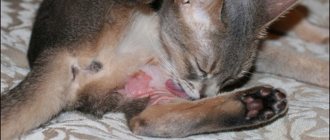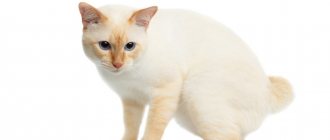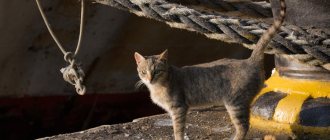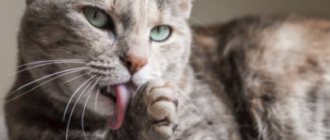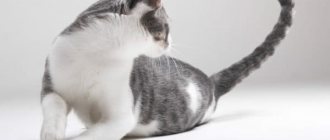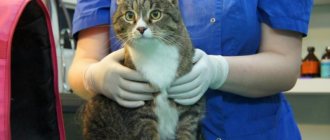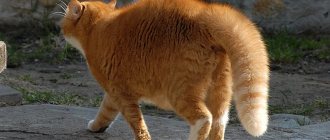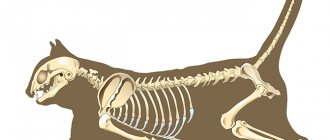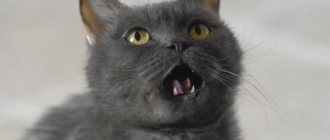The cat is always the center of attention. It is impossible not to pay attention to it. Yes, she often reminds herself of herself. If a cat's tail is wet, the owner will immediately notice it.
This situation is not necessarily associated with something bad. First, you need to understand whether spilled oil or another substance is causing the problem. The cat could just get dirty. But if your tail is constantly wet, there may be several reasons.
Natural cause in cats
Your cat may have a wet tail due to the onset of the reproductive estrous cycle, popularly called estrus. A similar condition occurs in cats during sexual arousal. At this time, the animal’s body prepares for the process of mating, fertilization and pregnancy.
Estrus occurs in 4 stages:
- proestrus - takes 1-3 days, the cat attracts cats to her, but does not let them get close;
- estrus – lasts about 5 days, mating occurs;
- diestrus – 2-19 days, excitement subsides, most often pregnancy occurs;
- anestrus - sexual rest.
A discharge under the tail appears during the mating stage. At this time, the animal does not look like itself, purrs, and shows excessive tenderness. It often licks its genitals, from which a clear secretion is released. The first heat can begin at the age of 4 to 18 months, depending on the breed. What to do in this case?
There may be several options. The cat can be matched with a male, sterilized, or wait until everything goes away on its own. But for this you will have to be patient. Typically, estrus goes away within 5-15 days. If this does not happen, you should contact your veterinarian.
If estrus does not stop for a long time, a uterine infection may be suspected in the cat. This is a serious disease that threatens the life of the animal. It is impossible to do without veterinary control.
Pyometra occurs due to hormonal changes that occur in the genital tract of a mature cat. The cause of the disease is often pregnancy that does not occur within several heat cycles. During estrus, the cervix is slightly dilated. Because of this, bacteria enter the reproductive organ. If the walls of the uterus are thickened due to unsuccessful attempts to get pregnant, bacteria begin to develop in them.
The infection manifests itself as purulent vaginal discharge. They can be noticeable under the tail, on the fur, on the bed.
If the disease is confirmed, the specialist will recommend removal of the uterus and appendages.
Causes of discharge from the anus
Discharge in a cat during diarrhea or constipation is quite normal and quite common. They manifest themselves in different ways, but are fairly easy to identify, so they are not too dangerous. The owner may also notice a small amount of blood clots in them. This symptom disappears completely with complete recovery. Therefore, you should not worry too much about this.
But if the discharge from either the anus in a cat or the vaginal area in a cat is purulent or mucous in nature and has a characteristic odor, we can talk about the presence of an infection.
Often this can be associated with problems with the genital organs of cats. But there are other options that require careful testing, special tests and smears. Here you should seek the help of a specialist as soon as possible so as not to aggravate the situation and alleviate the cat’s suffering.
© shutterstock
Often the cause of discharge from the anus is inflammation of the paraanal glands. Previously, many were inclined to think that such problems were directly related to the abundant use of dry food in the diet of pets. However, it turned out that this is a myth. Often, discharge appears due to the unusual structure of the intestine itself . For example, you may notice frequent attempts by the animal to sit on its hind legs or walk along the floor. Such manifestations of attempts to get rid of excess secretions should be immediately noticeable to the owner.
Anal gland problem
Cats quite often have problems associated with the excretory system . If your cat has a wound under his tail that is not related to injury, you should consult a veterinarian. It can be caused by a blockage of the sebaceous glands near the anus.
The disease is called inflammation of the paraanal glands. The secretion from the glands spreads throughout the body and leads to inflammation of neighboring tissues. An abscess appears. Left untreated, it can make it difficult for your cat to go to the toilet. Then blood poisoning occurs.
When the glands under the tail become inflamed, you may notice a discharge with a strong odor, an ulcer, a fistula, or a lump.
The problem can be treated with medications and gland cleaning. To prevent it, it is important to balance the cat’s diet and monitor the condition of the sebaceous glands. Then it won’t be wet under your tail either.
Not only adult cats, but also babies can get sick. So, if a kitten’s tail is very wet, most likely he has cystitis. In this case, not only the back part will be wet, but also the paws and tail. The kitten loses a lot of fluid, which is important to replenish. The reason lies in poor kidney function.
Treatment must be prescribed by a veterinarian. With proper therapy, the body will recover within a few days.
Absolutely every cat, regardless of its age, breed and living conditions, tries, as far as possible, to keep itself in ideal (by their standards) cleanliness. It is for this reason that the mustachioed pet carefully licks its fur, body, each paw, tail several times a day with great diligence and, of course, does not ignore its own genitals.
However, excessive zeal in the form of constant licking of the genital area can often alert vigilant owners and make them think about going to a specialist at the nearest veterinary clinic.
What are paraanal glands?
Anal (paraanal) glands are paired glands located at the anus. They look like small “bags” and secrete a secretion that performs various functions. One of them is recognizing the opposite sex and attracting them for further mating.
Other functions performed by the paraanal glands:
- protection from enemies (scaring away),
- marking the occupied territory,
- maintaining metabolism in the body,
- attracting partners.
During inflammatory processes, the functions of the glands are disrupted. Because of this, the pet experiences serious discomfort. In advanced cases (for example, with the development of an abscess), this problem can lead to serious and irreversible consequences. However, it is possible to avoid them if you know all the most important things about the causes and signs of inflammation.
Reasons for this behavior
In cats, constant licking of the genitals can be caused by inflammation of the prepurcial sac - the so-called skin fold of the foreskin that forms the space between the head of the penis and the skin. The folds of skin contain preputial lubricant that surrounds the cat's penis.
whitish-yellow smegma of the foreskin, may occasionally accumulate along the entire perimeter of the preputial opening. Such discharge is considered normal by veterinarians. If for some reason an inflammatory process begins in the area of the foreskin, then this fluid includes inclusions of blood, pus or urine.
The reasons why a cat licks its tail may be as follows:
- Disease of the foreskin, including the occurrence of neoplasms (cancer) in this area, mechanical damage, balanoposthitis (inflammation of the foreskin).
- Diseases of the urethra: trauma, the formation of stones and their subsequent passage, neoplasia.
- Bladder diseases: stones, infectious inflammations, neoplasms,
- Pathology of the prostate gland: prostatitis, cysts, hyperplasia, neoplasms, abscess.
- Coagulopathy (bleeding) and thrombocytopenia that occurs in parallel with it (a decrease in the level of platelets in the blood) - such an ailment can be a consequence of poisoning with rat poison.
- Urinary incontinence - occurs due to displacement of the ureter, or improper functioning of the sphincter, which is responsible for the amount of urine released.
- The cat simply performs part of his daily toilet routine by thoroughly licking his genitals after going to the toilet.
- An animal can lick a wound under its tail. Surely every person has heard the point of view that a cat always heals itself by licking sore spots.
- A cat may lick under its tail due to the fact that it suffers from constipation; the painful sensations create constant torment for it, from which the pet tries to get rid of it in all available ways.
- Itching in the anus can also cause excessive licking under the tail; in this case, the owner should pay attention to the cat’s feces, if it contains traces of helminthic infestations, this particular cause must be gotten rid of.
- A cat may start licking its tail as a result of being in a stressful situation: moving to a new place of residence, castration, remodeling a house, having new family members or pets - absolutely all innovations can cause a cat to panic and plunge it into a depressive state.
Diagnosis of the disease
If a cat constantly licks its tail, then it is worth talking about the presence of a disease that can only be determined by a veterinarian. The owner, turning to a veterinary clinic for help, will certainly be faced with the following procedures:
- Submission of general urine and blood tests, as well as biochemical blood tests,
- Submitting urine for bacterial culture (this action is necessary for specialists to exclude the presence of an infection in a pet located in the urinary tract area),
- Carrying out cytology and other bacterial studies,
- If bloody discharge appears, the animal will have to undergo coagulation; this procedure is also necessary to identify the cause related to blood clotting disorders,
- X-ray of the abdominal cavity (helps to identify the presence of an inflammatory process, for example, prostate disorders),
- Ultrasound of the abdominal cavity.
Treatment is based on the results of the tests, which will help establish the true clinical picture of the cat’s disease.
If the cat turns out to be absolutely healthy, the owner should not even worry about the fact that the cat is constantly licking its genitals. Let him do this for his own health, because it’s nice to have a clean cat in the house.
If this habit is caused by the animal having a disease, then you should follow all the recommendations of the treating veterinarian and fight for the health of your pet.
Urinary tract diseases should be eradicated with the help of drugs such as Phytoelita Healthy Kidneys, KotErvin.
Also, veterinarians often prescribe antibiotics in such cases - Sinulox, Amoxiclav, Cefazolin, Tsiprolet.
Fenbendazole, Pyrantel, Albendazole will help cope with helminthic infestations.
Levomikol ointment can help heal wounds under the tail; in this case, the cat should be wearing an Elizabethan collar, since this product has an unpleasant bitter taste.
Urolithiasis is a disease accompanied by the formation and deposition of urinary stones, or sand, in the renal pelvis, bladder or urethra.
Causes . Stones can form as a result of chronic infection of the bladder or its partial obstruction, metabolic disorders, hormonal disorders of the parathyroid glands, lack of vitamins A and D in the diet, and excessive feeding of imported feed. In cats, after castration, stones and sand may form in the bladder.
Symptoms. Before blockage of the urinary tract occurs, the disease occurs without pronounced clinical signs. Animals' appetite decreases and depression and drowsiness may occur. At times, blood is found in the urine, especially with active movements of the animal. The presence of stones in the bladder is manifested by a frequent urge to urinate and restlessness. When the urinary tract is blocked, the disease manifests itself as urinary colic. The duration of attacks can reach several hours. Between attacks the animal is sharply depressed, lies indifferently, and has difficulty getting up. Urination is frequent and painful. Urine is excreted with difficulty, in small portions and even drops, cloudy, mixed with urinary sand, which quickly precipitates. The color of the urine is dark, with a carsy tint caused by the admixture of blood.
Treatment. Aimed at eliminating stagnation of urine and restoring patency of the urinary tract. To relieve spasms of the urinary tract, antispasmodics are used, and sedatives and painkillers are prescribed at the same time. Urodane and urolite are used to destroy and remove urinary stones and sand. Substances that disinfect the urinary system are prescribed. Excellent results in the treatment of this disease can be achieved by using homeopathic and homotoxicological preparations
Source
There may be several reasons why a cat licks under its tail.
There are situations when the natural process of grooming cats can become obsessive. If a cat licks under its tail for an excessively long time and frequently, this may be a signal that there is a problem.
You should not ignore the fact that a pet tends to constantly lick itself in all places. It's possible that she's just in heat and the cat is bleeding from under her tail, however, there is a possibility that the cat has sores on her tail or something more serious. A clear sign of increased licking can be frequent regurgitation of hairballs.
This means it's time to take some action. If it is not possible to figure it out on your own, then it is advisable to show your pet to a veterinarian. After all, only a specialist who works in this field can understand such a situation, and who can identify the true cause and choose the right treatment.
This is a completely natural process that helps cleanse the wound. An animal cannot take care of itself in any other way. But such actions may be undesirable if the damage site is treated with some kind of agent or stitches are applied. To prevent such licking, the pet must limit access to the sore spot.
On average, an animal spends 30 to 50% of its total time licking its fur. This is quite a lot, so it happens that owners rarely pay attention to the current problem. Everything happens until it becomes noticeable that a significant part of the pet’s fur is missing or damage to its skin is observed.
Allergic reaction to food
One possible reason could be an allergy to some food. For example, some types of dry food may contain plant components that are naturally occurring in cats.
Source
The kitten's tail is wet
Having bought a small kitten, the owner often worries about its health. Any problems cause concern and a desire to help the baby. This is quite natural and commendable, as is a timely visit to the veterinarian.
Kittens are very playful. They happily run after everything that moves in front of their nose. Having noticed his tail, the baby can chase it. However, excessive attention to the tail may indicate the presence of worms or a lack of vitamins.
If the absence of hair and tail is unusual for the kitten’s breed, it means that it has a congenital pathology. It can occur due to abnormalities in intrauterine development. If a cat was given drugs during pregnancy that are teratogenic, such as griseofulvin, the kittens may be born not only without fur and a tail, but also deaf and blind, or die in the womb.
When a kitten has wetness under its tail, only a veterinarian can make a correct diagnosis when examining the animal. If the anal glands are inflamed, there may be an unpleasant odor, the kitten will constantly rub its butt and ride on it.
There may be some kind of viral disease - enteritis or coronavirus. To prevent the animal from dying, it needs professional medical care.
Young kittens may have kidney problems or cystitis immediately after birth. It's often wet under the tail. If the kitten does not get help, dehydration will occur, it will weaken and will not be able to suckle from its mother. Such kittens quickly lose weight.
To prevent dehydration, kittens are given warm saline solution often and little by little. At the first stage, a saline solution with catazal is injected. They also give cantarene with liarsine or “Healthy Kidneys”. The veterinarian called to the house must write out a detailed treatment plan.
When problems begin during childbirth in a cat, it is better to call a veterinarian at home.
Source
Recovery after treatment
After cleaning, rinsing or removing the anal glands, your cat requires special care. This will allow her body to recover faster and avoid unwanted consequences. The first thing that is necessary is to ensure the pet's comfort. Set up a bed for him in a warm place without drafts or blowing.
Maintain a therapeutic diet for 10-14 days. Eliminate solid food completely and provide constant access to fresh drinking water. Avoid excess carbohydrates in your animal's diet. It must be completely balanced so that the cat quickly recovers from a severe inflammatory process.
ZooForum: Wet under the rabbit’s tail – ZooForum
(others can give advice in a PM, indicating that the advice is not given by a veterinarian. But the forum is not responsible for THESE advice.)
Wet under the tail of the rabbit does not have diarrhea
Decorative lion-headed rabbit. Age - 3 weeks. The rabbit is already litter trained and does all his business there. But for some reason the fur near the tail is constantly wet. We tried washing it twice - it lasted for half a day, then it was wet again. And it's not diarrhea. Tell me, what's wrong with him?
This is urine. We poop normally - like peas. We went to the vet - we were told that it was most likely because he was taken away from his mother as a small child (at 3 weeks). They prescribed chamomile, gamavit, urological preparation and ampicillin. I'm afraid to give him ampicillin - they write everywhere that you can't give it to rabbits.
Good evening, Mikhail. Today we received the results of urine tests - not at all reassuring. I'm afraid to convey something incorrectly, so I'll give a photo of what the doctor wrote:
I forgot to say that the rabbit has not peed at all for two days. I have to squeeze urine out of him in the morning and evening. the penis is inflamed and swollen. This is what it looks like now:
Basically. It's not fatal, although it's strange. that cystitis developed at such an early age - you need to take an x-ray (perhaps the squeak is blocked in the urethra and therefore he cannot urinate) - if papaverine does not help, I would switch to no-shpa with analgin and still start antimicrobial treatment (biseptol).
Thanks for the quick response! It turned out that the whole issue was not in the kidneys. The rabbit has some kind of anomaly - either congenital or injured. The place where he should write from is overgrown. There is a fistula due to inflammation, either they will operate or. Tomorrow the doctors will decide what to do.
This means we are not the first... Mikhail, please tell me - can this be corrected? Or how to put it correctly - I don’t know. In general, the operation
Source
The cat smells bad and another problem.
I apologize in advance for the unpleasant topic - we recently adopted a one and a half year old cat, sterilized. She eats natural food. A problem arose - sometimes she has involuntary bowel movements - a small piece of feces jumps out, or today I picked her up - then I saw that she stained my robe (And then she ran to the potty for big business. And she also has there is a smell under the tail, it seems like she is washing herself, but the smell is still there, although the fur is clean. Could this be because three days ago they drove away worms from her? The cat was in foster care, she herself is from a shelter. Her curator and the woman who to whom she was in foster care, they didn’t talk about anything like that. I’m already afraid to pick her up, in case she accidentally shits on me. What should I do? The cat is active, eats well, purrs, it’s not clear from her that she’s sick. Maybe this is her structure her body or what? Help.
Yes, these are anal glands, most likely. Take her to the vet, he will clean them and she won’t get dirty anymore. In any case, the veterinarian will look and tell you why. No need to delay. If you feel sorry for the money now on a veterinarian, then later you will spend much more on treatment if you leave it to chance or self-medicate.
When we bought ours and brought it home (she was about 4 months old), she scared us for the first days and hid under the sofa. Climbing out from under the sofa, a very bright amber followed her! It smelled like tail. Then it all went away. Much later, such a stench suddenly appeared at the moment when the cat fished the hamster out of the cage and tried to eat it. I conclude that the smell of such a cat is emitted FROM STRESS, from excitement. In your case, it may also be due to the anti-worm medication.
Poultry meat cannot cause worms. In general, meat is frozen in the freezer for about a day before serving. There is no need to feed raw pork or veal.
When we bought ours and brought it home (she was about 4 months old)
Source
Signs of inflammation and abscess
Signs of inflammation develop gradually. They are accompanied by an increasing painful symptom. Due to pain and itching, the cat constantly licks the area of inflammation (tail and anus). The pet stops playing, spends time in solitude, practically does not move and constantly lies down. However, this is not the only symptom.
Other signs characteristic of inflammation of the paraanal glands:
- weakness,
- apathy,
- unpleasant specific odor from the pet’s body (does not disappear after washing),
- poor appetite (in later stages – refusal to eat),
- painful bowel movement,
- discharge from the anal glands.
With an abscess, this condition is accompanied by purulent or bloody discharge. In especially severe cases, body temperature rises. When stroking the affected area, the pet shows aggression and anxiety. Defecation is accompanied by severe pain, so the cat meows loudly on the tray.
Urinary incontinence in cats
Progressive urinary incontinence in cats is a serious problem, the solution of which can sometimes only be solved by a specialized specialist. You should not hope for self-healing: the longer you wait to visit the veterinarian, the less chance of getting rid of the disease. The same applies to another similar problem - fecal incontinence in cats. This nuisance is less common, but it is no less dangerous for the emotional and physical health of the pet.
First of all, the owner must make sure that the pathology is really present. Sometimes incontinence is confused with banal bad manners, a manifestation of instincts, protest or an attempt to attract attention. With urinary and/or fecal incontinence in cats, behavior changes:
Incontinence in cats leads to severe stress, as a result of which the pet becomes nervous, fearful, less sociable or aggressive.
You should not limit your fluid intake without your veterinarian's advice. A cat won't pee less because she hasn't drunk enough water. But dehydration is a common consequence of such an attempt to get rid of “unauthorized” puddles.
dripping, in which liquid is released in small portions constantly. There are small damp “dots” on the floor, on the bedding, on the furniture;
a permanent form in which the liquid literally flows out as it forms. The more the cat moves, the stronger the “leakage”;
urgent form, in which the cat experiences a sudden urge, but cannot help it. The pet leaves a puddle where it stood or lay, looks scared, sometimes meows loudly and presses its ears in fear;
a stressful form in which a cat cannot hold back urine at a moment of strong emotional stress, fear, joy, surprise, etc.
Source
Unconventional approaches
Today, veterinarians have the opportunity to expand medical care for animals using unconventional approaches. Some advice in this regard can be found in Peter Urton's book Eczema Freedom in Three Easy Steps.
The innovative techniques and recipes presented in this unique manual really work against weeping eczema. At the same time, they are simple, accessible, and help to rid the animal of illness in a short time.
If you want to learn more about weeping eczema in cats, we advise you to become a subscriber to our blog in order to receive new interesting information in a timely manner. In addition, in your comments you can share with us your thoughts on this issue.
Goodbye, see you again!
The tail (butt) smells bad!
In general, I noticed today that the dog began to smell bad... well, the smell is a little like herring. I decided to sniff it.. I started from the head and reached the tail.. without even lifting the tail, I understood where the smell came from. He didn’t smell like that before and his butt was clean. And this smell is just standing there... the dog is lying next to me or walking nearby and I feel this smell!
I had to look under his tail... usually his butt is clean, but here there is some kind of whitish accumulation in the wrinkles (sorry). In the evening there was more of this substance on my little one’s bottom. even the fur became dirty and the color became more yellowish, and the smell seemed to become similar to the smell of discharge from a pussy (sort of).
Show it to the vet. If the anal glands are clogged, they should be cleaned at the veterinarian. The procedure is quick, but not very pleasant for the dog. And what the glands are clogged with stinks - it’s just terrible.
Thank you, I called the vet to the house today, but forgot to ask about the rear problem. because We served both a dog and a cat... in general there was enough to do. Tomorrow I’ll probably take you to the nearest clinic, if it’s just glands, I think they’ll clean them there too.
You can wash it))) don’t smell such aromas until tomorrow))) only if it’s glands, then you need to do it with gloves.))) The smell is corrosive)))
And what does it come from? When a dog goes to the toilet a lot, these glands must cleanse themselves. Why is something wrong in your case, ask your vet. When our male dog had this a few years ago, a change in diet helped us. (Switched to hypoallergenic food) now they’ve forgotten what that was (ttt)
Thanks again))) Well, about the food. We eat Akana food and cottage cheese in the morning, sometimes canned meat for dogs with rice... although most likely we will soon give up natural food altogether (except for cottage cheese). before that we ate ANF, everything was fine with the dog, only the food was poorly digested and the ears began to get dirty...
Prevention, advice to owners
In the treatment and prevention of “wet tail”, it is important to follow the rules of hygiene - clean the cage in a timely manner, replace food and water daily, wash your hands after interacting with animals (since the infection is easily transmitted from one rodent to another).
If several animals are kept in one cage, then the sick should be immediately isolated and the cage should be thoroughly cleaned.
Further care should begin with healthy pets, and then only carry out hygiene procedures on sick animals.
It is not advisable to keep a sick pet in the same room as healthy ones.
Several times a day, the cage of a sick rodent is disinfected with antiseptics and the bedding is changed - these actions help to avoid re-infection.
The kitten's tail is wet
Having bought a small kitten, the owner often worries about its health. Any problems cause concern and a desire to help the baby. This is quite natural and commendable, as is a timely visit to the veterinarian.
Kittens are very playful. They happily run after everything that moves in front of their nose. Having noticed his tail, the baby can chase it. However, excessive attention to the tail may indicate the presence of worms or a lack of vitamins.
If the absence of hair and tail is unusual for the kitten’s breed, it means that it has a congenital pathology. It can occur due to abnormalities in intrauterine development. If a cat was given drugs during pregnancy that are teratogenic, such as griseofulvin, the kittens may be born not only without fur and a tail, but also deaf and blind, or die in the womb.
When a kitten has wetness under its tail, only a veterinarian can make a correct diagnosis when examining the animal. If the anal glands are inflamed, there may be an unpleasant odor, the kitten will constantly rub its butt and ride on it.
There may be some kind of viral disease - enteritis or coronavirus. To prevent the animal from dying, it needs professional medical care.
Young kittens may have kidney problems or cystitis immediately after birth. It's often wet under the tail. If the kitten does not get help, dehydration will occur, it will weaken and will not be able to suckle from its mother. Such kittens quickly lose weight.
To prevent dehydration, kittens are given warm saline solution often and little by little. At the first stage, a saline solution with catazal is injected. They also give cantarene with liarsine or “Healthy Kidneys”. The veterinarian called to the house must write out a detailed treatment plan.
When problems begin during childbirth in a cat, it is better to call a veterinarian at home.
Source
Tail diseases in cats
Symptoms of cat diseases are described with the goal that a caring owner can promptly detect the onset of a serious disease, and if it is detected, immediately contact a professional veterinarian rather than self-medicate.
If the initial symptoms of an impending disease are identified in time, this will help prevent further development of the infection in your pet’s body, as well as avoid a situation where the consequences may be irreversible.
Tail disease in cats can occur for various reasons. These may be previously experienced injuries, such as bruises, wounds, fractures, dislocations or some other biomechanical damage. There are diseases that are quite difficult to determine: these are foreign tumors of various origins, osteomyelitis, eczema, vertebral caries or contractures and others. Any of these diseases requires specific treatment, which must be carried out either in a veterinary clinic or at home, but in strict accordance with the recipes and recommendations given by a professional veterinarian.
Tail ulcer
Short-haired cats often suffer from ulcers that form on their tails. These ulcers can be located throughout the tail, including at the root of the tail, which can cause necrosis of the vertebrae of the caudal process.
This disease is specific and requires strict pharmacological treatment, as well as special recommendations to the owner for treating the cat at home. The process of treating a tail ulcer also includes cleaning it of dirt and, if formed, a crust. After this procedure, the affected area of the tail should be treated with antiseptic powder and lubricated with a special product prescribed by the veterinarian. Kubatol aerosol is often used for these purposes. After such treatment, the affected area is lubricated with ointment. This is m
Source
There may be several reasons why a cat licks under its tail.
There are situations when the natural process of grooming cats can become obsessive. If a cat licks under its tail for an excessively long time and frequently, this may be a signal that there is a problem.
You should not ignore the fact that a pet tends to constantly lick itself in all places. It's possible that she's just in heat and the cat is bleeding from under her tail, however, there is a possibility that the cat has sores on her tail or something more serious. A clear sign of increased licking can be frequent regurgitation of hairballs.
This means it's time to take some action. If it is not possible to figure it out on your own, then it is advisable to show your pet to a veterinarian. After all, only a specialist who works in this field can understand such a situation, and who can identify the true cause and choose the right treatment.
This is a completely natural process that helps cleanse the wound. An animal cannot take care of itself in any other way. But such actions may be undesirable if the damage site is treated with some kind of agent or stitches are applied. To prevent such licking, the pet must limit access to the sore spot.
On average, an animal spends 30 to 50% of its total time licking its fur. This is quite a lot, so it happens that owners rarely pay attention to the current problem. Everything happens until it becomes noticeable that a significant part of the pet’s fur is missing or damage to its skin is observed.
Allergic reaction to food
One possible reason could be an allergy to some food. For example, some types of dry food may contain plant components that are naturally occurring in cats.
Source
Prevention of inflammation of the paraanal glands
Inflammation and abscess of the paraanal glands are a serious blow to your cat's health. However, it is possible to avoid it. The main thing is to follow simple recommendations for prevention from experienced veterinarians.
- Your pet should lead an active lifestyle (in accordance with its age). If you don't have much time, special toys and exercise equipment for cats will help with this.
- If your animal's anal glands are often clogged, consult a specialist and discuss the issue of removing them.
- Try to avoid cheap liquid food and do not give your pet small bones, as well as foods that can cause gastrointestinal injury.
- At the first signs of inflammation, consult a doctor. Don't forget about regular preventive examinations.
- Carry out anthelmintic treatment once every 6-12 months. This completely eliminates the possibility of developing parasitic diseases.
Inflammation or abscess of the paraanal glands is dangerous to the health and life of the cat. A seemingly insignificant problem can lead to dangerous consequences, including death. That is why we strongly recommend that you follow preventive measures, and if the first signs of inflammation appear, contact your veterinarian immediately!
Source
Baldness under the cat's tail
I just noticed a large area of baldness under the cat’s tail, the cat is 7 years old, neutered at six months, we feed him Proplan, Gurmet canned food, and give him vitamins. In the last few days I noticed that the cat is constantly licking himself, about 3 weeks ago the cat was cut, he was very fluffy, now the fur has grown a little, and under the tail there is just clean pink healthy-looking skin, the first thought was that he was licking himself. I looked around the rest of my body - nothing. She smeared it with iodine, again constantly licking herself there, now the iodine is licking it. What is this. I read about lichen - they write that it should be covered with a crust or scales. The cat is domestic and does not interact with other animals.
It’s strange. My cats where *** also have bald skin there. This seems normal. You made a fuss in vain, it seems to me. It’s better to go to the vet.
Well, take him to the doctor and show him. No one will diagnose you on the forum. And you don’t have to write what you feed - this is generally the tenth thing.
What do worms have to do with it? I hope that I made a fuss in vain, as you write, now I see that it’s still not completely bald, there is hair, but Vasya still feels somehow strange.
Blockage of the anal gland, this often happens in cats, this causes itching, he licks himself, and then licks himself. We need to see a veterinarian. My cat had this, a minute procedure, the veterinarian squeezes out the contents of the gland with his hands, an anti-inflammatory injection and that’s it.
my cat does too. They took me to the doctor, prescribed injections from the placenta (150 rubles per injection), and prescribed a bunch of pills. Overgrown. Six months later, same problem. Again to the doctor, they took a tick test. Nothing. They said it was something hormonal and couldn’t be treated. We smear him with YAM ointment, hold him in our hands for an hour and a half without licking him, the bald spots go away. Six months later the same picture (
Blockage of the anal gland, this often happens in cats, this causes itching, he licks himself, and then licks himself. We need to see a veterinarian. My cat had this for a minute
Source
Symptoms
Watery diarrhea, which leads to the characteristic “wet tail” symptom. However, loose stools appear last: initially, there is a lack of appetite and lethargy.
The incubation period of the disease is about 5-7 days.
Diarrhea does not always mean colibacillosis. Sometimes loose stools in an animal occur due to stress, changes in diet, and other “harmless” factors. Any diarrhea is a cause for concern, so you should contact your veterinarian at the first sign of it.
Tail diseases in cats
Descriptions of the symptoms of cat diseases are given so that a loving owner can detect a dangerous disease in time, after which he would not engage in “self-medication”, but turn to a professional veterinarian.
If the initial signs of an emerging disease are identified in a timely manner, it becomes possible to prevent the development of infections in the pet’s body and not lead the situation to irreversible consequences.
In cats, the occurrence of various tail diseases can have various causes. This may be the consequences of wounds, bruises, dislocations, fractures or other biomechanical damage.
More difficult to define diseases may also occur: osteomyelitis, foreign tumors of various origins, vertebral caries or contractures, eczema, etc.
Each type and degree of disease requires specific treatment, which can be carried out in a veterinary clinic or at home using a prescription and recommendations obtained from a professional veterinarian.
Tail ulcer
It is quite common for short-haired cats to develop ulcers on their long tails. These ulcers can reach all the way to the root of the tail, causing necrosis of the vertebrae of the caudal process. A specific disease has strict pharmacological treatment and special recommendations for treating the cat at home by the owner himself. In addition, for ulcers, treatment of the tail includes the process of clearing away dirt and crusts that have formed. Then the affected area of the tail must be treated with antiseptic powder and lubricated with a prescribed special agent, in particular, it is possible to use cubatol aerosol. Subsequently, ointment is applied to the affected and pre-treated area. Suitable here: liquid Vishnevsky liniment, syntomycin ointment or streptomycin. The treated area of the cat's tail is wrapped
Source
Treatment: main stages and methods
Treatment of inflammation or abscess of the paraanal glands should only be carried out by an experienced veterinarian in Moscow. We strongly do not recommend trying to help your pet at home. This will only worsen an already difficult situation.
The first step in treating inflammation is diagnosing the animal's condition. The veterinarian examines the affected area, interviews the owner (about the severity of symptoms, the degree of their manifestation, etc.), after which he assesses the cat’s condition and prescribes treatment.
Cleaning
If you consult a doctor in a timely manner (at the first stage of the inflammatory process), then treatment will be limited to cleaning the paraanal glands. This procedure does not require special conditions, so it can be performed in the clinic or at home, but only by a professional veterinarian.
Before cleansing the glands of accumulated secretion and secretion, it is necessary to palpate them. This will allow you to determine the consistency of the contents and select a cleaning method. If the secretion is liquid, then the external method is used, if it is dense, the method of rectal sanitation is used.

